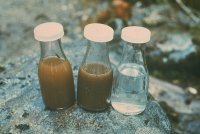|
Project WILD Activities
The following activities are derived from the Project WILD Activity Guide.*

Water Canneries p. 9
Students investigate a stream or pond using sampling
techniques.
The Edge of Home p. 177
Students explore the concepts of ecotones by visiting places where habitats overlap.
Fishy Who's Who p.195
Students do an inventory of fish habitats that exist in their area, obtain information about the
various fish species that live in these habitats, and locate the fish species on a map according to
where they live.
Fashion a Fish p.197
Students design a variety of fish adapted for various aquatic
habitats.
Oh Deer (Aquatic Extension) p. 206
Students become "salmon" and components of habitat in a highly involving physical
activity.
Checks and Balances p.227
Students become managers of a school of salmon in a paper-and-pencil and
discussion-based game.
Net Gain, Net Effect p.232
Students conduct a simulation to explore the evolution of fishing and the effects of changing
technology on fish populations.
Where Have All the Salmon Gone? p. 245
Students graph and interpret actual fish population data in relation to historical events.
Aquatic Times p.310
Students investigate, write, and produce a newspaper that
features aquatic information and issues.
To Dam or Not to Dam p. 312
Students role play individuals representing differing perspectives and concerns relating to a
complex issue.(option for younger students)

Deadly Waters p. 322
Students analyse the pollutants found in a hypothetical river. They graph the quantities of
pollutants and make recommendations about actions that could be taken to improve
habitat.(option for younger students)

Living Research: Aquatic Heroes and Heroines
p. 361
Students identify people - through news media, current events, or
other means - who have made contributions to conserving or preserving aquatic environments.
They research these contributions, and write a biography.
Example: Roderick L. Haig-Brown
Something's Fishy Here! p. 371
Students read and discuss the story "Something's Fishy Here," inventing their own endings
that lead to environmental action in their community.
Project WILD. Canadian Wildlife Federation. © Western
Regional Environmental Education Council, 1995.
Top of page.
|


